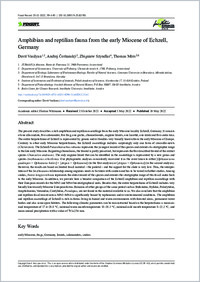Amphibian and reptilian fauna from the early Miocene of Echzell, Germany
DOKPE
- Vasilyan, Davit ORCID JURASSICA Museum, Route de Fontenais 21. 2900 Porrentruy, Switzerland; Department of Geosciences, University of Fribourg, Chemin du musée 6, 1700, Fribourg, Switzerland
- Čerňanský, Andrej ORCID Department of Ecology, Laboratory of Evolutionary Biology, Faculty of Natural Sciences, Comenius University in Bratislava, Mlynská dolina, Ilkovičova 6, 842 15 Bratislava, Slovakia
- Szyndlar, Zbigniew Institute of Systematics and Evolution of Animals, Polish Academy of Sciences, Slawkowska 17, 31-016 Kraków, Poland
- Mörs, Thomas ORCID Department of Palaeobiology, Swedish Museum of Natural History, P.O. Box 50007, 104 05 Stockholm, Sweden; Bolin Centre for Climate Research, Stockholm University, Stockholm, Sweden
- 10.05.2022
Published in:
- Fossil Record. - Pensoft Publishers. - 2022, vol. 25, no. 1, p. 99-145
English
The present study describes a rich amphibian and reptilian assemblage from the early Miocene locality Echzell, Germany. It consists of one allocaudate, five salamander, five frog, one gecko, chamaeleonids, anguine lizards, one lacertid, one skink and five snake taxa. The entire herpetofauna of Echzell is represented by genera and/or families very broadly known from the early Miocene of Europe. Contrary to other early Miocene herpetofaunas, the Echzell assemblage includes surprisingly only one form of crocodile-newts (Chelotriton). The Echzell Palaeobatrachus robustus represents the youngest record of the species and extends its stratigraphic range to the late early Miocene. Regarding chameleons, the frontal is partly preserved, but represents the first described frontal of the extinct species Chamaeleo andrusovi. The only anguine lizard that can be identified in the assemblage is represented by a new genus and species Smithosaurus echzellensis. Our phylogenetic analyses consistently recovered it as the sister taxon to either [Ophisauriscus quadrupes + Ophisaurus holeci] + [Anguis + Ophisaurus] (in the first analysis) or [Anguis + Ophisaurus] (in the second analysis). However, the results are based on limited fossil material – the parietal – and the support for the clade is very low. Thus, the interpretation of the Smithosaurus relationship among anguines needs to be taken with caution and has to be tested in further studies. Among snakes, Natrix longivertebrata represents the oldest record of the species and extends the stratigraphic range of this fossil snake back to the early Miocene. In addition, we provide here a broader comparison of the Echzell amphibian and reptilian assemblage with their European records for the MN3 and MN4 biostratigraphical units. Besides that, the entire herpetofauna of Echzell includes very broadly known early Miocene European forms. Remains of other groups of the same period such as Bufonidae, Hylidae, Pelodytidae, Amphisbaenia, Varanidae, Cordylidae, Pseudopus, are not found in the material available to us. We also conclude that the amphibian and reptilian fossil record across MN3–MN4 is significantly biased by taphonomic and/or environmental conditions. The amphibian and reptilian assemblage of Echzell is rich in forms living in humid and warm environments with forested areas, permanent water bodies and also some open habitats. The following climatic parameters can be reconstructed based on the herpetofauna: a mean annual temperature of 17.4–28.8 °C, minimal warm month temperature 18–28.3 °C, minimal cold month temperature 8–22.2 °C, and mean annual precipitation with a value of 791±254 mm.
- Faculty
- Faculté des sciences et de médecine
- Department
- Département de Géosciences
- Language
-
- English
- Classification
- Palaeontology
- License
- Open access status
- gold
- Identifiers
-
- DOI 10.3897/fr.25.83781
- ISSN 2193-0074
- Persistent URL
- https://folia.unifr.ch/unifr/documents/319942
Statistics
Document views: 87
File downloads:
- foss-rec_article_83781_en_1: 330
